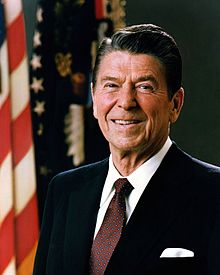WASHINGTON—Ronald Reagan was inducted into the U.S. Department of Labor’s Hall of Honor last week. No, this is not The Onion. You are still reading LaborPress. This actually happened.

The honor is given to “Americans whose distinctive contributions have elevated working conditions, wages, and overall quality of life for American families.” It is hard to understand how Reagan “elevated wages.” He was the only President who did not raise the federal minimum wage since it was enacted in 1938. It stayed frozen at $3.35 an hour for his full two terms.
The Hall’s original inductees in 1989 included Samuel Gompers, founder of the American Federation of Labor; John L. Lewis, the United Mine Workers’ eloquent and militant leader; former Secretary of Labor Frances Perkins, a job-safety pioneer; and A. Philip Randolph, who spearheaded the campaign to desegregate industry during World War II. They would quickly be followed by socialist railroad-union leader Eugene V. Debs, Walter P. Reuther of the United Auto Workers, National Labor Relations Act sponsor Sen. Robert Wagner, and organizer Mother Jones, and a few years later by United Farmworkers leader Cesar Chavez and Terence V. Powderly of the 19th century Knights of Labor.
George W. Bush’s administration extended honors to business owners who said their “employees were the secret to [their] company’s success,” such as John Willard Marriott and Charles R. Walgreen, but also inducted United Brotherhood of Carpenters founder Peter J. McGuire and AFL-CIO President Lane Kirkland. The Obama administration’s inductees included the workers of the 1968 Memphis sanitation strike, the Chinese workers who built the western part of the transcontinental railroad in the 1860s, and gay-rights pioneer Frank Kameny.
Reagan, however, may be the first inductee with an explicitly anti-labor record, although he was the only President to have led a major union. As head of the Screen Actors Guild from 1947 to 1952 and 1959-60, he won actors the right to residuals—but he also purged Communist Party members and other leftists, part of the Cold War blacklists that deprived the labor movement of some of its most dedicated and militant organizers. In 1946, he prevented SAG from supporting a strike by movie set builders on the grounds that their union, the Conference of Studio Unions, was part of a Communist plot to take over Hollywood.
Reagan is particularly ironic company for Cesar Chavez. During the United Farmworkers’ 1965-70 strike to win union recognition, Reagan, then governor of California, called them “barbarians.” In 1969, he defied their boycott of nonunion grapes by eating grapes on television. He also vetoed legislation that would have given farmworkers collective-bargaining rights and made them eligible for unemployment benefits.
Reagan’s plaque, unveiled March 1, says he “worked to expand freedom for Americans and for those living abroad under repressive communist regimes that curbed the right to belong to a free trade union.” Too bad he didn’t respect those rights on this side of the Iron Curtain. He was responsible for the most destructive single event in the history of the U.S. labor movement in the past 60 years: his mass firing of striking air-traffic controllers in 1981.
More than 12,000 members of the Professional Air Traffic Controllers Organization went on strike on the morning of Aug. 3, 1981, demanding a pay increase and a shorter workweek so they could more easily cope with the high-stress job. Reagan gave them 48 hours to return to work, brought in supervisors and military personnel as strikebreakers, and on Aug. 5, fired the more than 11,000 strikers who had refused to cross the picket line. He banned them from working for the federal government, and PATCO—ironically, one of the few unions to endorse Reagan for President in 1980—was decertified a few months later.
This had both practical and symbolic results. It signaled the end of the postwar social contract between business and labor, in which most large employers had largely agreed to accept unions and negotiate wage and benefit increases. It inaugurated an era when management felt empowered to demand pay cuts and try to obliterate unions. Permanently replacing striking workers with scabs was legal before 1981, but it generally just wasn’t done.
Reagan’s breaking the PATCO strike also symbolized the end of the New Deal era, in which working people were believed to have a right to a decent living, and elevated the cold-blooded mentality of Ayn Rand acolytes, in which if someone is willing to do a job for three broken peanuts an hour, then that is the highest wage anyone doing that job merits.
The tactics the Charter/Spectrum cable-TV company is currently using against the year-long strike by its technicians—hiring scabs, attempting to eliminate workers’ health benefits and pensions, and refusing to negotiate—would not be happening without the door opened by Ronald Reagan.

